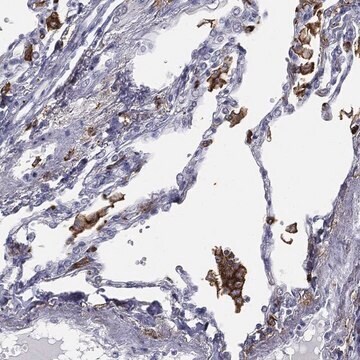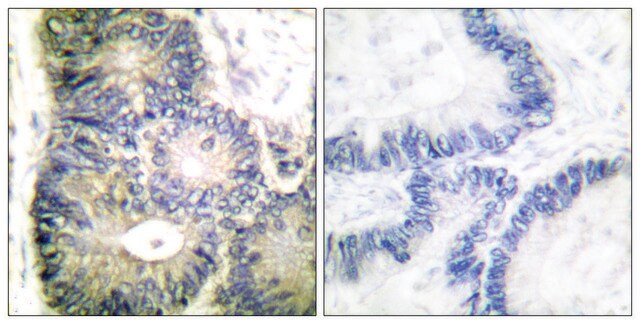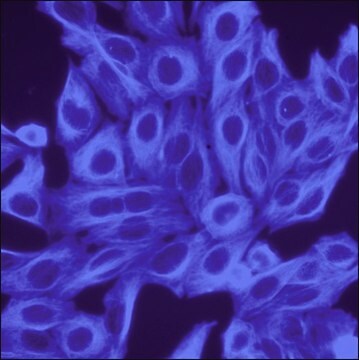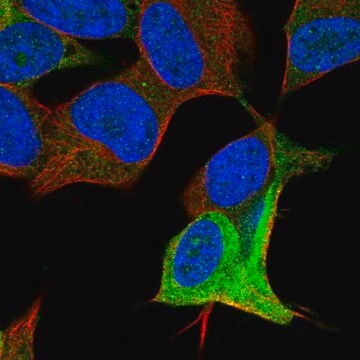SAB4200631
Monoclonal Anti-CYBA antibody produced in mouse
clone CB-64, purified from hybridoma cell culture
同義詞:
Cytochrome b558 subunit alpha, Neutrophil cytochrome b 22 kDa polypeptide, Superoxide-generating NADPH oxidase light chain subunit, cytochrome b-245 alpha polypeptide, p22-PHOX
登入查看組織和合約定價
全部照片(4)
About This Item
分類程式碼代碼:
12352203
NACRES:
NA.41
推薦產品
生物源
mouse
品質等級
抗體表格
purified immunoglobulin
抗體產品種類
primary antibodies
無性繁殖
CB-64, monoclonal
形狀
buffered aqueous solution
物種活性
bovine, mouse, rat, monkey, human, canine
濃度
~1 mg/mL
技術
flow cytometry: 5-10 μg/test using HeLa cells.
immunoblotting: 0.5-1 μg/mL using whole extracts of HeLa cells.
immunofluorescence: 5-10 μg/mL using HeLa cells.
同型
IgM
UniProt登錄號
運輸包裝
dry ice
儲存溫度
−20°C
目標翻譯後修改
unmodified
基因資訊
human ... CYBA(1535)
mouse ... Cyba(13057)
rat ... Cyba(79129)
一般說明
Monoclonal Anti-CYBA (mouse IgM isotype) is derived from the hybridoma CB-64 produced by the fusion of mouse myeloma cells and splenocytes from BALB/c mice immunized with a synthetic peptide corresponding to a sequence at the internal region of human CYBA, conjugated to keyhole limpet hemocyanin (KLH). The small subunit, p22phox subunit, also known as cytochrome b245, alpha polypeptide/light chain (CYBA) is membrane bound,which is expressed in phagocytic, endothelial and vascular smooth muscle cells. This gene is located on human chromosome16q24
免疫原
Synthetic peptide corresponding to a sequence at the internal region of human CYBA .
應用
Monoclonal Anti-CYBA antibody produced in mouse has been used in:
- immunoblotting
- flow cytometry
- immunofluorescence
生化/生理作用
In prostate cancer cells downregulation of cytochrome b245, alpha polypeptide/light chain (CYBA) was reported to inhibited cell proliferation and colony formation, through AKT and ERK1/2 signaling pathways, indicating CYBA has a role in tumor angiogenesis and tumor growth. Mutations in this gene causes an autosomal recessive forms of chronic granulomatous disease (AR220CGD).
外觀
Supplied as a solution in 0.01 M phosphate buffered saline, pH 7.4, containing 15 mM sodium azide as a preservative.
免責聲明
Unless otherwise stated in our catalog or other company documentation accompanying the product(s), our products are intended for research use only and are not to be used for any other purpose, which includes but is not limited to, unauthorized commercial uses, in vitro diagnostic uses, ex vivo or in vivo therapeutic uses or any type of consumption or application to humans or animals.
未找到適合的產品?
試用我們的產品選擇工具.
儲存類別代碼
10 - Combustible liquids
水污染物質分類(WGK)
WGK 1
閃點(°F)
Not applicable
閃點(°C)
Not applicable
Qi Li et al.
Biochimica et biophysica acta, 1833(12), 3375-3385 (2013-10-12)
Excessive generation of reactive oxygen species (ROS) in cancer cells is associated with cancer development, but the underlying mechanisms and therapeutic significance remain elusive. In this study, we reported that levels of ROS and p22(phox) expression are greatly increased in
CYBA encoding p22phox, the cytochrome b558 alpha polypeptide: gene structure, expression, role and physiopathology
Stasia MJ
Gene, 586(1) (2016)
Is the C242T Polymorphism of the CYBA Gene Linked with Oxidative Stress-Associated Complications of Prematurity
Huizing MJ, et al.
Antioxidants & Redox Signaling, 27(17) (2017)
Gorka San José et al.
Clinical science (London, England : 1979), 114(3), 173-182 (2008-01-11)
Oxidative stress plays a key role in the pathophysiology of several major cardiovascular diseases, including atherosclerosis, hypertension, heart failure, stroke and diabetes. ROS (reactive oxygen species) affect multiple tissues either directly or through NO depletion. ROS induce cardiovascular dysfunction by
NADPH oxidase subunit p22phox-mediated reactive oxygen species contribute to angiogenesis and tumor growth through AKT and ERK1/2 signaling pathways in prostate cancer
Li Q, et al.
Biochimica et Biophysica Acta - Molecular Cell Research, 1833(12) (2013)
我們的科學家團隊在所有研究領域都有豐富的經驗,包括生命科學、材料科學、化學合成、色譜、分析等.
聯絡技術服務








